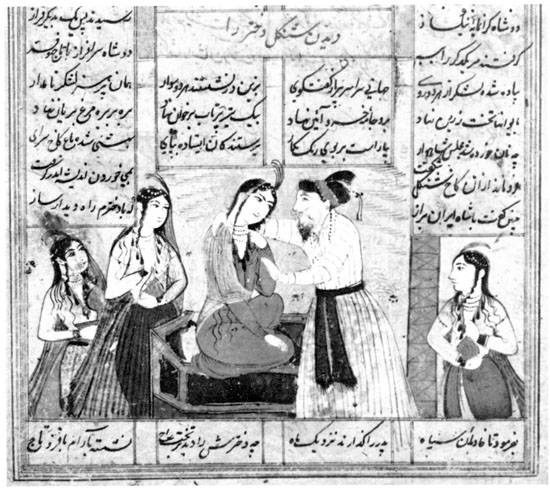Moʿin Moṣavver | Manuscripts | Shahnama of Ferdowsi
Šangol Prepares His Daughter Sapinud for Bahrām Gur
Location: Khalili Collection, London.. Formerly in the Kraus Collection, New York.
Page: 34.5 x 22.3 cm. (after Grube)
Painting: 7.3 cm. high x 14.5 cm. wide. (after Grube)
Text area: 23.5 x 14.5 cm.
Signature: not signed.
Bahrām Gur aspired to make Hind (India) a vassal of the Persian empire. He prepared a letter to King Šangol, ruler of Hind, and decided to deliver his own letter incognito. The letter offered, that In return for receiving tribute from Šangol, that Hind would be under the complete protection of the Persian empire. If he chose not to accept, there would be war. Šangol was set back by this demand, but after seeing Bahrām Gur's wrestling prowess, he conjectured that this was not a common ambassador, and had to be further tested. He requested Bahrām's assistance to rid Hind of two menaces, first an oversized vicious wolf, and then a dragon, hoping all the while that one of the monsters would do Bahrām in. But Bahrām swiftly dispatched both monsters. Following the advice of his ministers, Šangol offered Bahrām the hand of one of his daughters, and therewith became a vassal of Iran.
Šangol had three daughters. The painting portrays Šangol with four young ladies; the one in the center is of royal rank and may be intended to be his daughter Sapinud. Since Šangol did not know which daughter Bahrām would select, it is likely that this scene would have occurred sometime after Bahrām's selection, and Šangol is here preparing her for her departure with Bahrām to the Persian court. Šangol sports a beard and mustache; his hair is drawn back on his head and retained with a jewel-studded band; his long pleated Indian gown is knotted at the waist by a sash with long loose ends that hang almost to his knees. The princess sits before him, to the left, on an elevated throne. She has long braided hair with jewels and the emblem of rank over her forehead, and a transparent shawl wrapped about her shoulders. The female attendants are similarly attired in long pleated skirts, tight semi-transparent blouses, and long braided hair. The backdrop for the scene is a nondescript palace wall with a suggestion of a tiled column..
Painting references:
Grube, Kraus, no.164 (illustrated).
Text references:
Warner, VII, pp.126-28.
Photo after Grube
Robert Eng
Last Updated: November 26, 2015 | Originally published: November 26, 2015
Manuscript F, no. 7-128
Location: Khalili Collection, London.. Formerly in the Kraus Collection, New York.
Page: 34.5 x 22.3 cm. (after Grube)
Painting: 7.3 cm. high x 14.5 cm. wide. (after Grube)
Text area: 23.5 x 14.5 cm.
Signature: not signed.
Bahrām Gur aspired to make Hind (India) a vassal of the Persian empire. He prepared a letter to King Šangol, ruler of Hind, and decided to deliver his own letter incognito. The letter offered, that In return for receiving tribute from Šangol, that Hind would be under the complete protection of the Persian empire. If he chose not to accept, there would be war. Šangol was set back by this demand, but after seeing Bahrām Gur's wrestling prowess, he conjectured that this was not a common ambassador, and had to be further tested. He requested Bahrām's assistance to rid Hind of two menaces, first an oversized vicious wolf, and then a dragon, hoping all the while that one of the monsters would do Bahrām in. But Bahrām swiftly dispatched both monsters. Following the advice of his ministers, Šangol offered Bahrām the hand of one of his daughters, and therewith became a vassal of Iran.
Šangol had three daughters. The painting portrays Šangol with four young ladies; the one in the center is of royal rank and may be intended to be his daughter Sapinud. Since Šangol did not know which daughter Bahrām would select, it is likely that this scene would have occurred sometime after Bahrām's selection, and Šangol is here preparing her for her departure with Bahrām to the Persian court. Šangol sports a beard and mustache; his hair is drawn back on his head and retained with a jewel-studded band; his long pleated Indian gown is knotted at the waist by a sash with long loose ends that hang almost to his knees. The princess sits before him, to the left, on an elevated throne. She has long braided hair with jewels and the emblem of rank over her forehead, and a transparent shawl wrapped about her shoulders. The female attendants are similarly attired in long pleated skirts, tight semi-transparent blouses, and long braided hair. The backdrop for the scene is a nondescript palace wall with a suggestion of a tiled column..
Painting references:
Grube, Kraus, no.164 (illustrated).
Text references:
Warner, VII, pp.126-28.
Photo after Grube
Robert Eng
Last Updated: November 26, 2015 | Originally published: November 26, 2015
